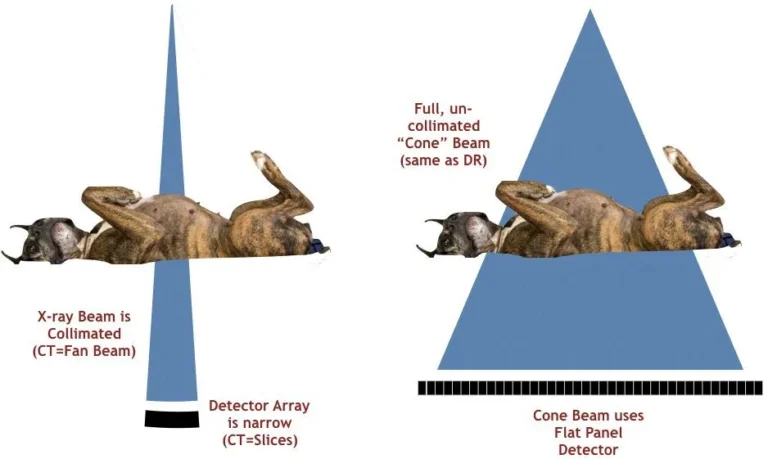There are three primary reasons veterinarians invest in a computed tomography (CT) scanner: to uncover previously undiagnosed pathologies, unlock the benefit of interventional treatments, and improve clinical outcomes. This is an investment into your clinic’s standard of care and economic success.
You may already know that two types of scanners on the market produce volumetric image data: slice CT (also called “traditional CT”) and Cone Beam scanners. Each of these technologies has its pros and cons, but the two principal differentiators concerning image quality and logistics are:
- Motion Artifacts
- Contrast Resolution
- Scanning Logistics Impact the Level of Motion Artifacts
Motion artifacts in CT imaging are the most significant inhibitor of image quality. This comes into play when the patient moves during a single “acquisition” or gantry rotation.
Because traditional CT scanners rotate at 30 to 120 rpm (an entire rotation in 0.5 to 2 seconds), the amount of motion artifact is non-existent or minimal. Also, if there is motion within a given rotation, the artifact appears only in that “slice” of data, which is on the order of 1 to 2 cm thick; the rest of the dataset is unaffected.
With Cone Beam technology, the X-ray tube and detector are more prominent and heavier, so the rotation speed is much slower—on the order of 2 to 4 rpm (an entire rotation in 15 to 30 seconds). Suppose there is any motion during this rotation. In that case, the entire image (often 14 to 17 cm of anatomy) is impacted in a way that cannot be corrected with image processing without literally manipulating the dataset based on some imprecise assumptions of motion uniformity. So, any motion during the scan leads to the need to repeat the scan completely.
Contrast Resolution Caused by Scattered X-rays
Image quality in all X-ray imaging—especially CT—depends strongly on the assumption that the X-ray passes in a straight line from the generator through the anatomy to the detector. Because the reconstruction of a 3-D image depends on a continuously rotating 2-D dataset, if there is any variance from this straight-line assumption, the contrast resolution, i.e., the ability to differentiate issues of slightly different densities, suffers. This is particularly important in the Thorax and abdomen of the patient, where these subtle differences are typically the reason you would choose CT as the imaging modality in the first place.
With traditional CT, the X-ray beam and the detector array are collimated to a narrow “slice” of anatomy, so the “straight-line” assumption holds true. The detector array does not capture scattered radiation, so no errant data is recorded. With Cone Beam technology, though, the X-ray beam and flat panel detector are not collimated, so the scan both a) produces more scattered radiation and b) captures virtually all the scattered X-rays. These are errant data points (destined initially for other pixels) whose acquisition significantly reduces contrast resolution and, therefore, diagnostic power.

Appropriate Image QualityInadequate Image Quality
Conventional CT
- Soft-tissue applications where superior contrast is needed
- Abdomen and Thorax, where fast gantry rotations are required to avoid motion
- Ability to reconstruct in soft tissue, bone, and lung algorithms
- Multi-phased contrast studies
- Spatial resolution is less detailed than cone beam; however, it does not change clinical outcomes.
Cone Beam
- Small anatomies (head, feet, patients <20lbs) where the amount of scatter is decreased because of the size of the scan volume
- Bony structures (skulls, elbows, feet) where the amount of scatter is decreased relative to soft tissue because of tissue density
- Soft tissue application inferior with contrast resolution
- Increase in motion artifacts (mainly soft tissue)
- Ability to reconstruct in soft tissue, bone, and lung algorithms
- Multi-phased contrast studies
SOUND TOP TIP
Computed Tomography is an advanced imaging modality. Prior to purchasing a CT scanner, it may be prudent to consult with an ACVR ACVR-boarded radiologist.
Conclusion
Though there are several factors to consider when purchasing a CT scanner, image quality should be at the top. Traditional CT offers superior image quality because it is less affected by motion artifacts, and its components are collimated to optimize contrast resolution, allowing for reconstructions in bone, lung, and soft tissue algorithms. The acquisition speed and ability to reconstruct in a soft tissue algorithm allow traditional CT to perform contrast studies, including multiphase (portal, arterial, and venous phase). Consider these advantages when deciding which CT would be the right fit for your veterinary practice.

